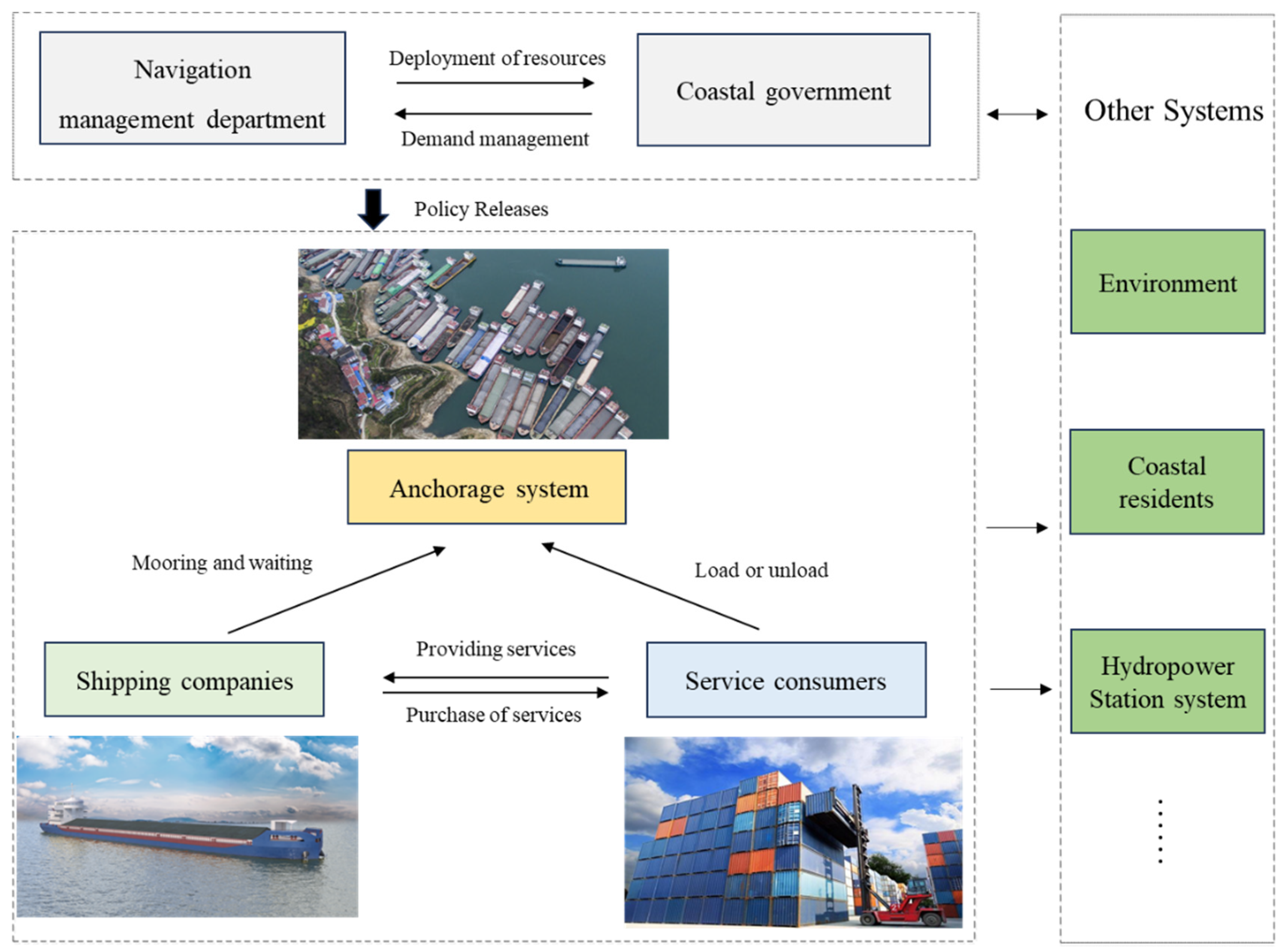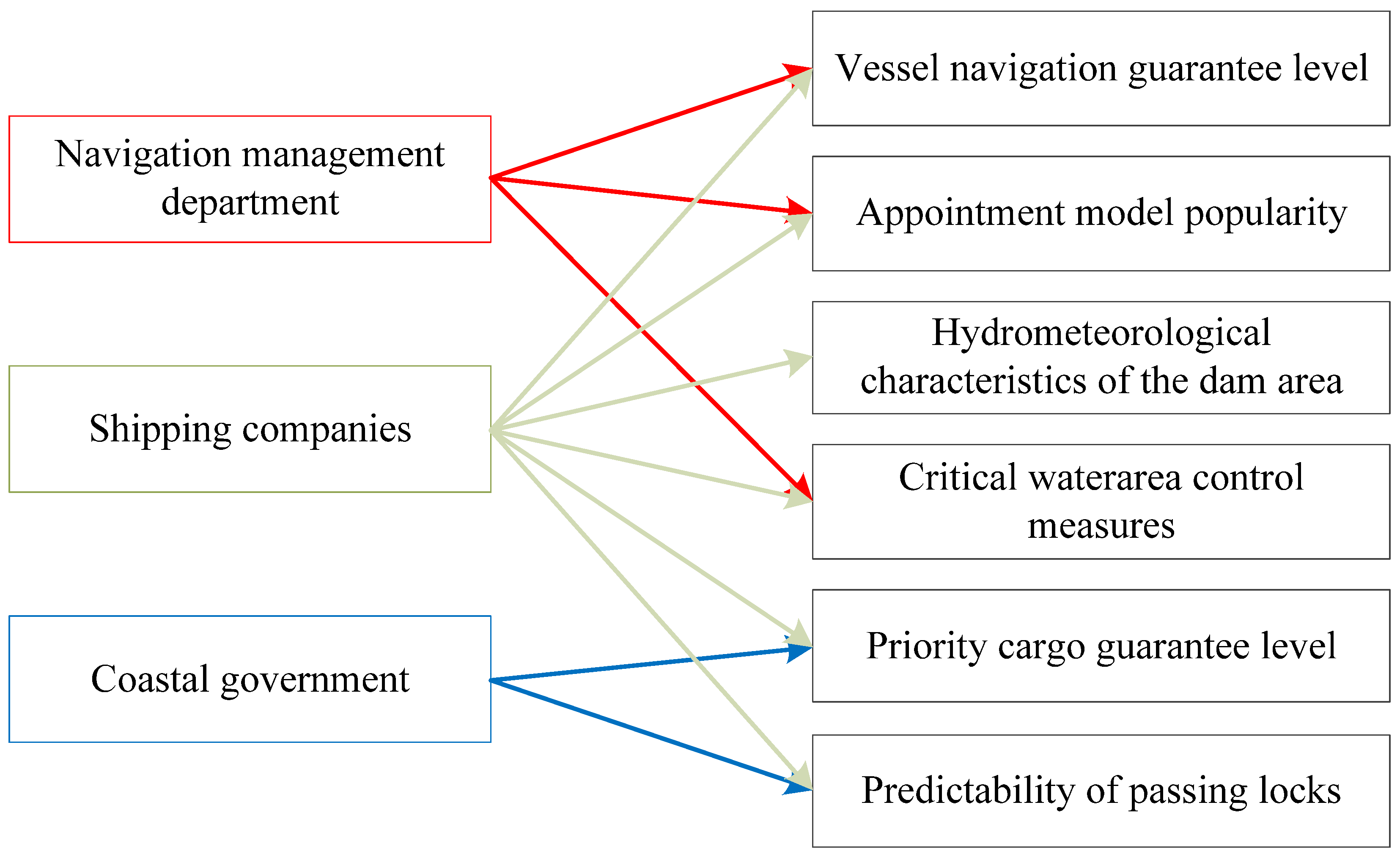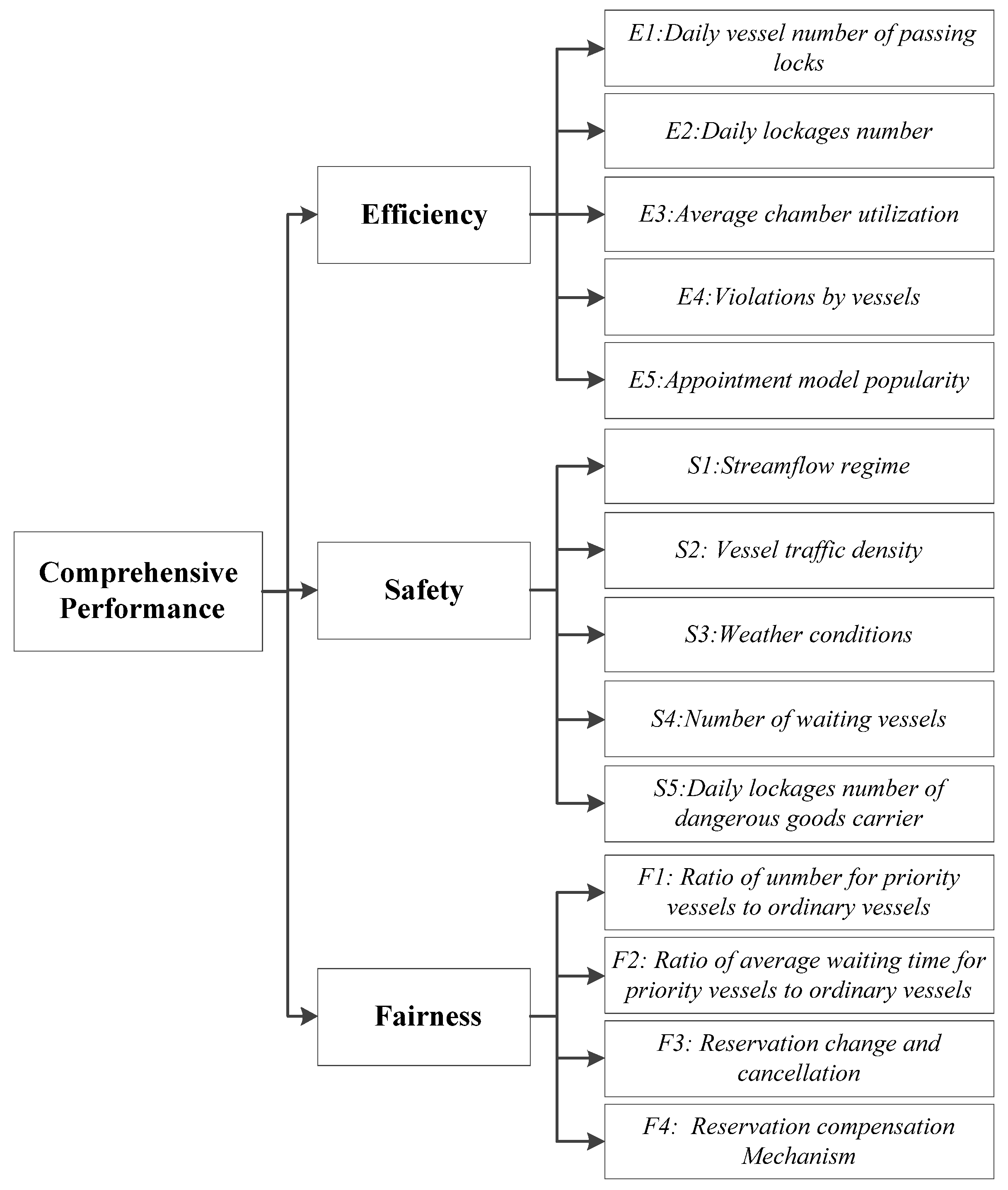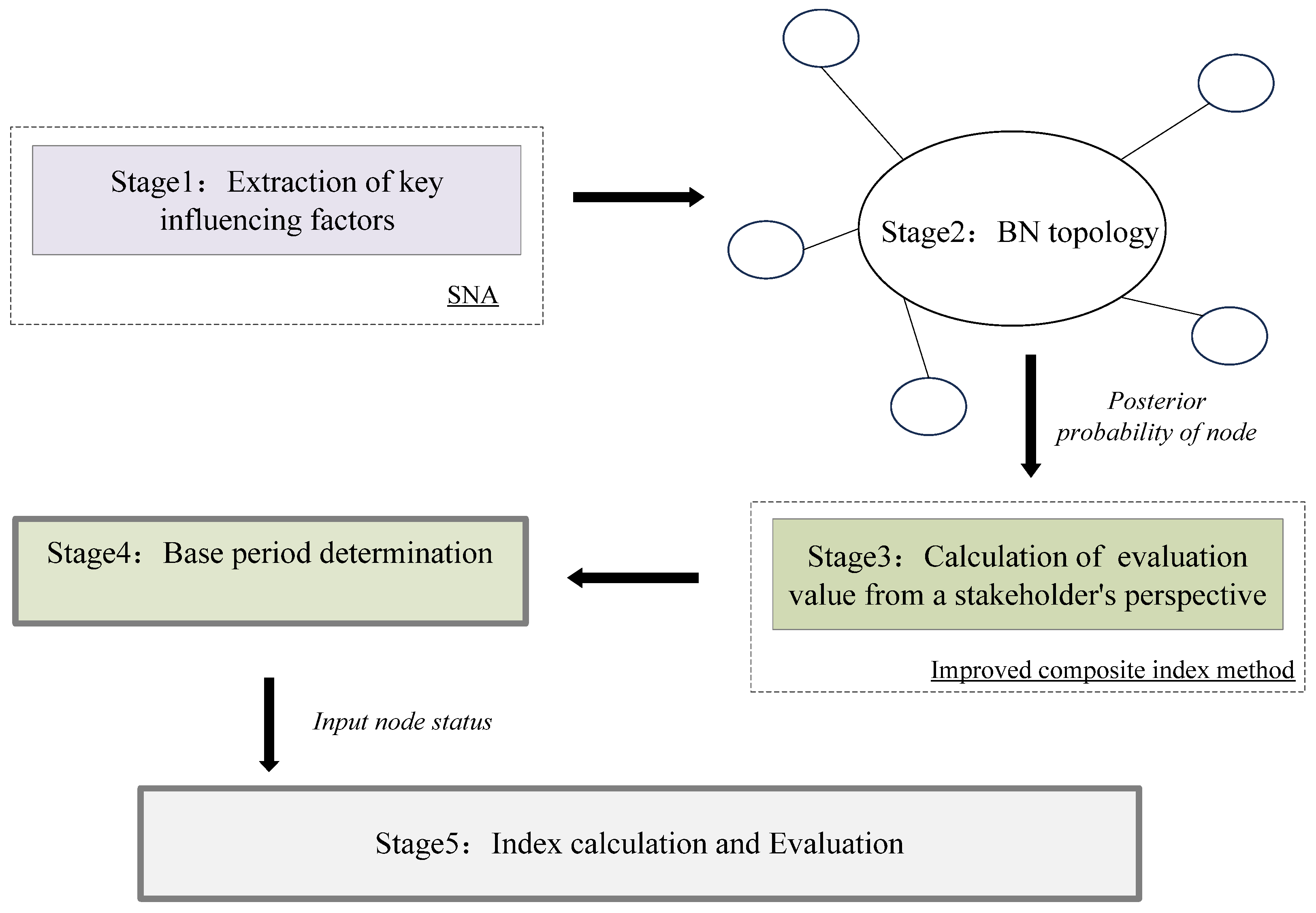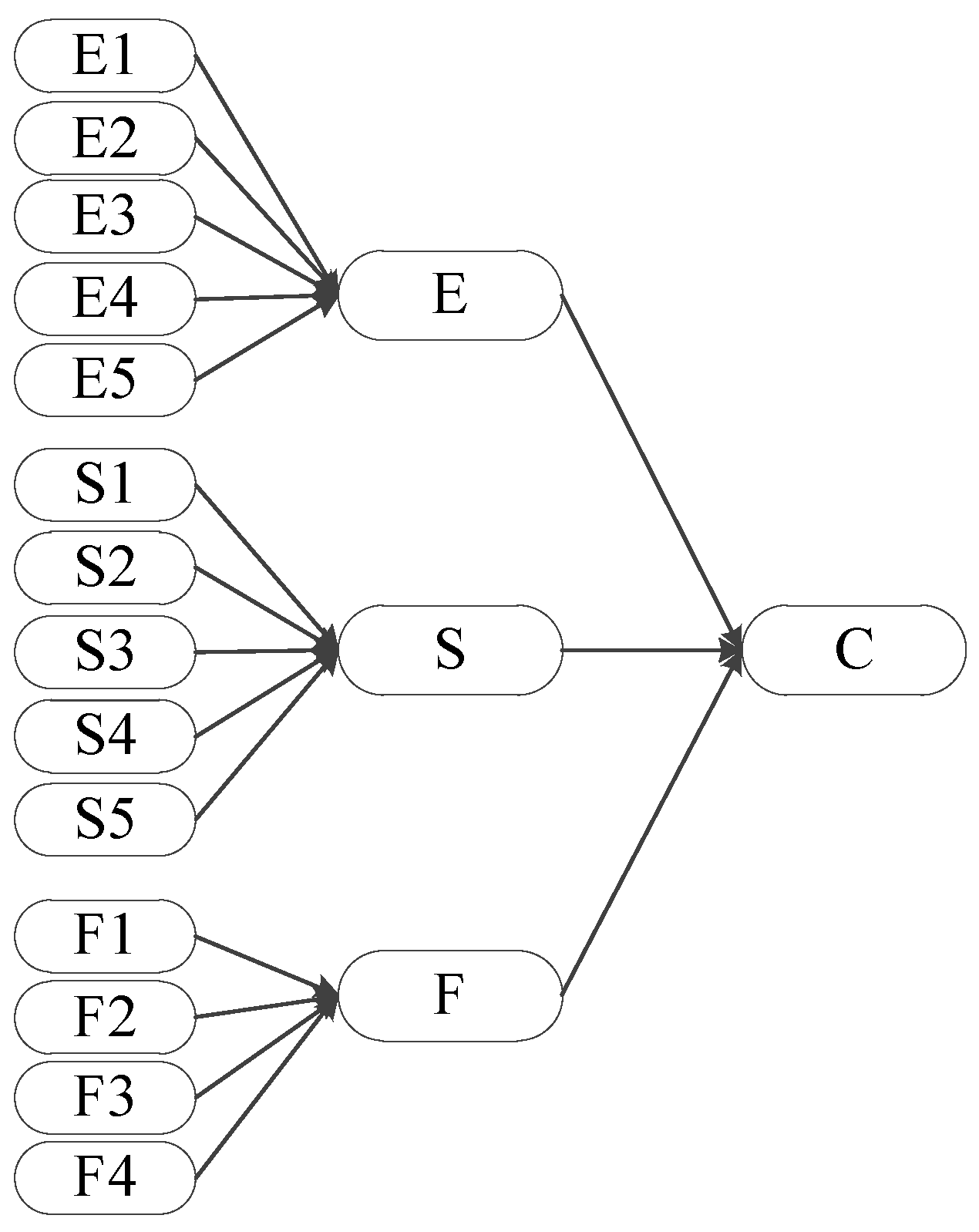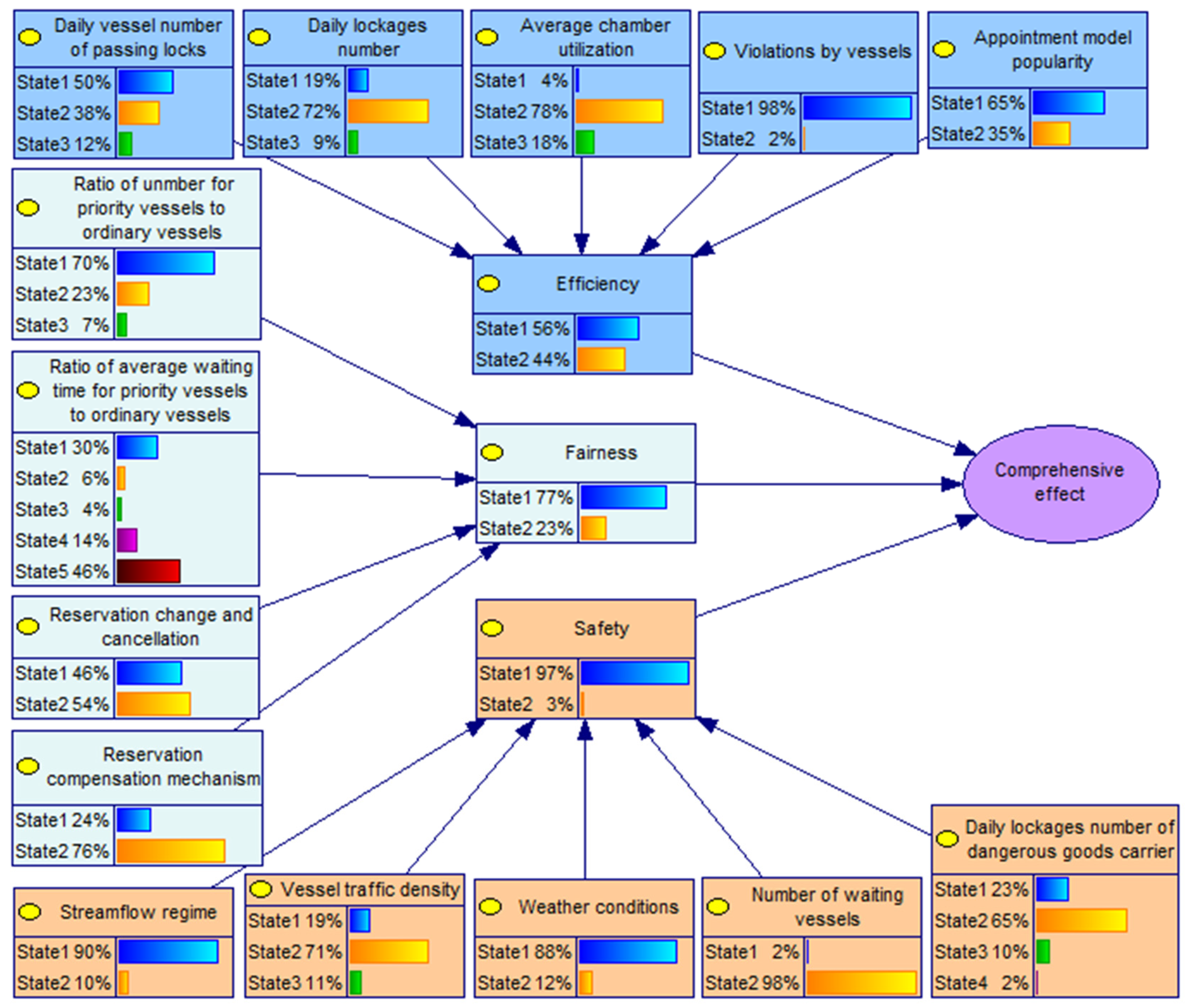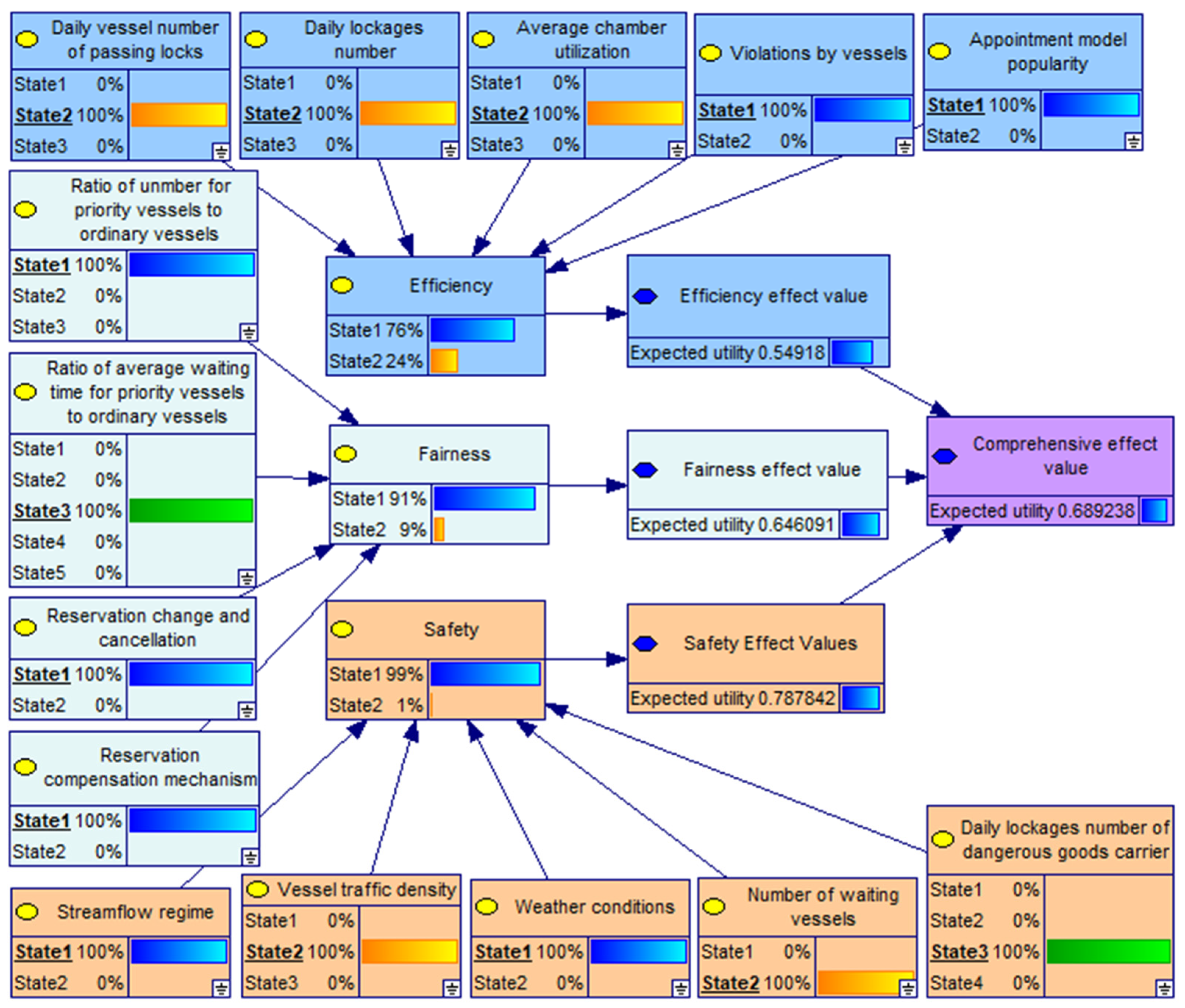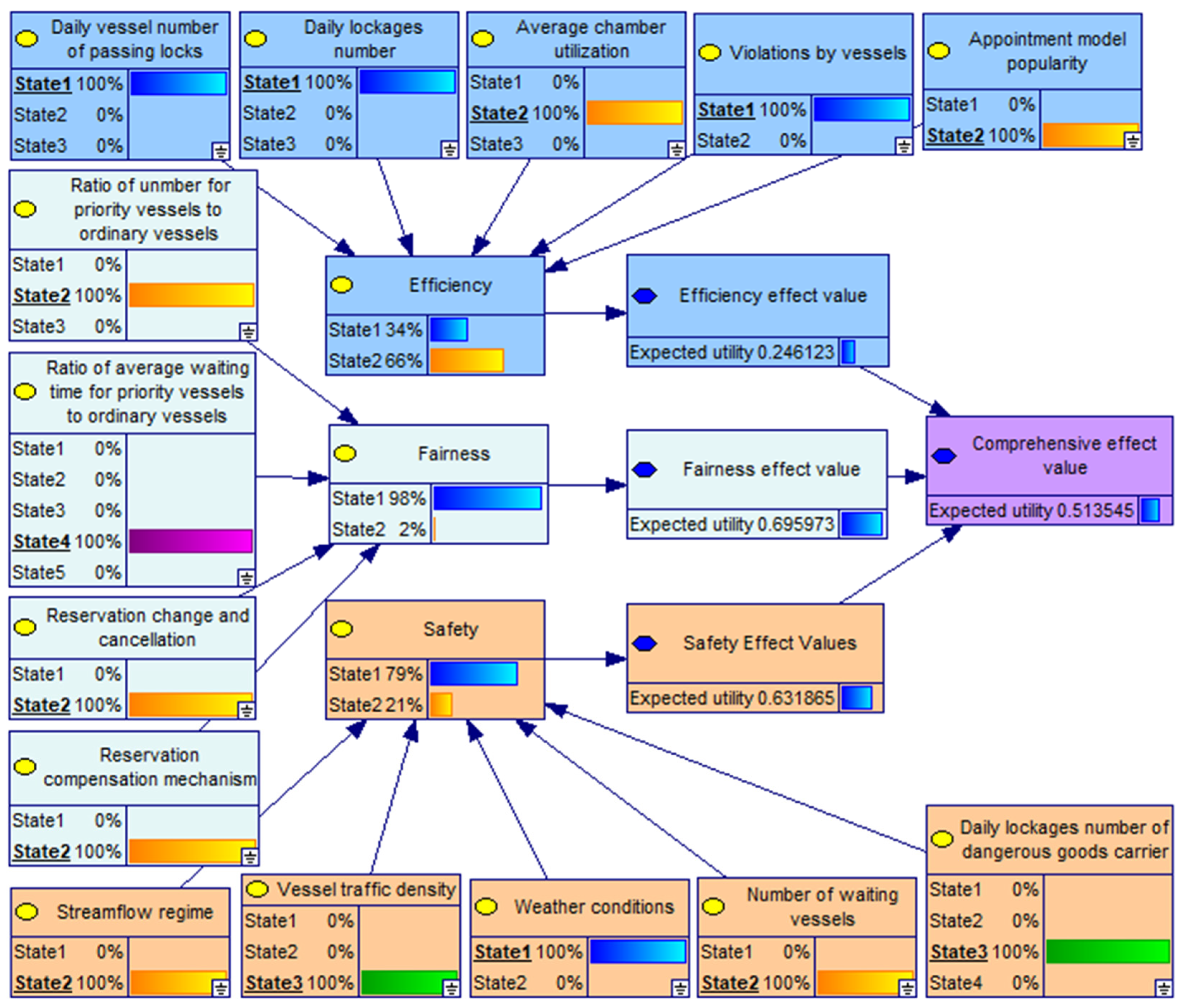1. Introduction
Navigation may efficiently relieve the pressure on land transportation of bulk goods within the catchment due to its vast volume, excellent flexibility, and low transportation cost characteristics. As an essential navigational structure, locks play a role in channelization and flow regulation, which are widely used in the Yangtze River Basin in China [
1,
2], the Albert Canal in Belgium [
3,
4], the Mississippi River and its tributary Ohio River in the United States [
5,
6,
7], and the Panama Canal [
8], etc. The China Statistical Yearbook 2022 issued by the National Bureau of Statistics of China shows that, as of 2022, China’s inland waterway mileage totaled 127,600 km. China’s waterway freight turnover totaled 11,557.7 billion ton-km, which is 51.7% of the national freight turnover. Locks have a prominent position and role in today’s comprehensive transportation system. As an example, in 2022, the Three Gorges locks operated a total of 10,400 lockages, passing 40,600 vessels and 156 million tons of freight, a year-on-year increase of 6.78%. As control nodes on waterways, locks are also prone to behave as bottlenecks, restricting the transportation efficiency of the logistics network [
9]. Vessel navigation in the lock area is a complex system involving traffic management and service, lock operation, vessel operation, and freight organization. Many stakeholders are participating in the navigation process, including the authorities of maritime and lock operation management, shipping and logistics companies, shippers, and so on. The design and implementation of scheduling rules of lock navigation, which is conducted by the lock navigation authorities, should take the stakeholders into account and satisfy their concerns as much as possible.
For the evaluation of the performance of lock navigation scheduling rules, there is currently no comprehensive study that can address this issue. Reasonable rules should be selected to meet the demand of the vessels as much as possible to obtain a satisfactory scheduling performance. During the period of a relative surplus of vessels passing resources, the queuing rule based on FCFS (first come, first served) is usually adopted. Wilson [
10] analyzed the applicability of different queuing models based on the capacity of the locks. The results of the study showed that waiting time is an essential indicator for evaluating the effectiveness of lock scheduling rules in queuing mode by drawing on the scheduling model of transportation systems such as urban bus scheduling and terminal collector card reservation scheduling in case of congestion [
11,
12]. The rules of determining the comprehensive priority of vessels and implementing the reservation of vessels for passing locks are added to provide exclusive rights of passage for vessels transporting essential materials, to alleviate the contradiction between the demand for vessels and the passing capacity of locks, and improve scheduling performance [
13,
14]. In cases where the adoption capacity cannot be improved, it is crucial to evaluate the performance of scheduling rules in terms of fairness and safety.
However, the existing research on navigation scheduling rules focuses on the optimization of lock navigation efficiency and energy saving and emission reduction while neglecting the social attributes of locks as public infrastructure. Ritika [
15] provided a comprehensive definition of stakeholder theory in social services, and the study showed that stakeholders have a significant impact on the effectiveness and sustainability of public services. Locks are not a closed vessel navigation management system. A minor adjustment to the scheduling rule can have a significant impact on policymaking and implementation, coastal businesses and residents, and practitioners. Therefore, the attitudes of various stakeholders toward scheduling rules must be carefully considered, which is also lacking in existing research. The ultimate goal should be to play a role in the long-term development of society and economy through scientific and reasonable transportation modes. Therefore, the scientific evaluation of the performance of lock navigation scheduling rules will help to identify the appropriateness of the design and implementation of rules, discover the loopholes in scheduling management, and enhance the flexibility of the shipping network. The assessment also provides a more balanced and high-quality service to stakeholders. It promotes the orderly, healthy, and rational development of navigation.
The evaluation of the performance of lock navigation scheduling rules is jointly affected by multiple stakeholders based on the corresponding indicators. Therefore, it can be regarded as a typical multi-attribute group decision-making (MAGDM) problem. To rationalize the complex interactions among stakeholders and to avoid the subjective and ambiguous selection of indicators in the existing performance evaluation process, this study proposes an integrated social network analysis (SNA) and Bayesian network (BN) approach to construct an evaluation index system for the performance of lock navigation scheduling rules. Based on this, a composite index method based on the Bayesian network (BN) is proposed to solve the problem of evaluating the performance of lock navigation scheduling rules by expressing complex fuzzy information using the index value constructed based on the conditional probability of BN evidence nodes. The contribution of this study is as follows.
(1) Analyzing the business process of vessel passing locks by SNA’s relational orientation and positional orientation. Completion of the extraction of the three main stakeholders in the issue of lock scheduling: shipping companies, navigation management departments, and coastal governments. Identifying key factors affecting the performance of scheduling rules in conjunction with the focus of each stakeholder’s concerns.
(2) This is based on the coupling that exists between SNA and BN within the fields of graph theory and probability theory. The key influencing factors under the stakeholder perspective are categorized according to the dimensions of efficiency, fairness, and safety to construct an evaluation index system of the performance of lock navigation scheduling rules. The conditional probabilities of the output of its nodes in the BN can reveal the direction and strength of the factor’s action under different criteria. The evaluation index system provides ideas and references for researchers and decision-makers to realize the quantitative characterization of multidimensional system impact states under the condition of complex factors acting together.
(3) In order to measure the resilience of the transportation system under uncertainty, we propose a MAGDM method that combines a modified composite index method with the BN. This method is applied for the first time to the evaluation of the performance of lock navigation scheduling rules. Under specific circumstances, such as lock maintenance, the index value can still reflect the operation of the lock system in a stable manner. This involves a continuous dynamic characterization of the performance of scheduling rules through criterion index values and composite index values, which effectively reduces the distortion of the evaluation and decision-making information.
The remainder of this paper is organized as follows.
Section 2 presents a literature review, which mainly studies the stakeholder theory, the lock navigation scheduling rules, and the performance evaluation method. The identification of performance influence factors is described in
Section 3.
Section 4 presents a description of the index evaluation model for the performance of the lock navigation scheduling rules.
Section 5 presents the case study based on the evaluation case of the Three Gorges locks. The proposed evaluation method is applied to evaluate and analyze the performance of the scheduling rules during the maintenance period to verify their feasibility and superiority.
Section 6 presents the conclusions of this study.
4. Formulation of Index Model for the Performance Evaluation of Lock Navigation Scheduling Rules
In order to assess the performance of lock navigation scheduling rules, this study uses a Bayesian network model to analyze the influencing factors. Then, the improved composite index method [
37,
38,
39,
40] is used to downscale the evaluation of different stakeholders on the performance of scheduling rules, combine the conditional probability of factors in the Bayesian network for the measurement of the performance value, and construct an index-type evaluation model of the performance of lock navigation scheduling rules by the relationship between the base period of the lock navigation scheduling system and the performance value in the observation period. Meanwhile, the index contains an overall index and criterion node index, which can reflect the comprehensive operation performance of the model as well as describe the operation performance of the model under the criterion of efficiency, fairness, and safety. The evaluation process is shown in
Figure 4.
4.1. Bayesian Network Structure for Lock Navigation Performance Evaluation
The performance of lock navigation scheduling rules is the result of the joint action of multiple factors under the principles of efficiency, safety, and fairness, which fits well with the idea of the Bayesian network to influence the probability of the state of factors as a consequence evaluation. The Bayesian network (BN) is a method of inference evaluation based on uncertainty probability [
38,
39]. In a Bayesian network, variables are represented as nodes, and directed edges between nodes represent causal or dependency relationships between variables. Nodes are linked with probability distributions that represent their conditional probability distribution based on their parent’s state.
In the Bayesian network structure of a directed acyclic graph, determining the network nodes and their interactions is a key step in the construction of the structure, which can usually be achieved through data fitting for structure learning or based on the experience of experts to build a multilevel network structure. Since the evaluation index system of the performance of lock navigation scheduling rules fits well with the structure of the Bayesian network, this study transforms the three-layer index system according to the form of Bayesian network topology, as shown in
Figure 5. This network structure can be widely applied to lock scheduling scenarios, and the use of the BN topology reduces the complexity of the network under the comprehensive performance of multiple factors.
4.2. Factor Node Conditional Probability Calculation
The basic model of Bayesian networks consists of two parts: the determination of the network topology and parameter learning. In the above, the conditional probability tables of all nodes are obtained by using a large amount of sample data to train the parameters of the nodes in the constructed network.
The state value domain of each evidence node needs to be determined before parameter training. There are two main types of nodes: binary-type nodes and numerical-type nodes. As shown in
Figure 4, the weather condition node under security is a binary-type node, which exists in two states and can be defined as normal weather and special weather, respectively. The average daily number of vessels passing locks under efficiency is a numerical-type node, which exists in three states, and the boundary values can be determined according to the statistical data. For example, below 60 vessels is defined as state 1, above 70 vessels is defined as state 3, and between 60 and 70 vessels is defined as state 2.
For probability table preparation, this study uses maximum a posteriori estimation (MAP) for parameter learning; maximum a posteriori estimation is a method of Bayesian statistics to obtain point estimates of unknown parameters based on empirical data [
39]. In simple terms, MAP is a maximum likelihood estimation (MLE) concerning a priori laws. Assuming a total of
parameters for this study,
is the unobserved parameter to be estimated,
is the corresponding observed data,
is the prior probability of parameter
,
is the likelihood probability of
given parameter
, and
is the posterior probability of parameter A given the data
. The maximum a posteriori estimate
of parameter
is as follows:
In this study, GeNIe 2.0 software is used as a development environment to build a graphical decision-theoretic model, which performs exact inference and parameter learning through a visualization window and outputs a posteriori probability tables under a static or dynamic model to characterize the contribution of each node under the efficiency, fairness, and safety criteria.
4.3. Calculation of Weights and Evaluation Values from Stakeholder Perspectives
To ensure the relevance of the index to the object of study, there are differences in the impact of different criteria on stakeholders. The weights of different criteria factors in the comprehensive evaluation need to be calculated. The judgment matrix is constructed using the 1–9 scale method. Noting that
is the ratio of factor
to factor
and
is the number of factors, the judgment matrix is obtained by comparing the judgment factors at each level of the indicator level with each other as follows:
Multiply the elements of each row of the judgment matrix
corresponding to the level to be computed to obtain a new vector
.
is the
th root of
. Normalize the resulting vector to obtain the corresponding weight values
.
The set of stakeholders is , of which is the navigation management department, is the shipping companies, and is the coastal government. This leads to the weights of the efficiency factor , safety factor , and equity factor in the comprehensive evaluation of performance and the weights of each stakeholder for efficiency, safety, and equity.
Let
be a total of
stakeholders that form a set
. The judgment indicator
of each stakeholder form a set
, and the corresponding judgment indicator is denoted as
, where
denotes the
th judgment indicator in the
th stakeholder. Then the judgment matrix
is as follows:
The fuzzy evaluation indicators are shown in
Table 2.
The composite index method can transform the indicators into individual indices of the same measure [
32] to understand and analyze the trends and changes in the data. The fuzzy composite evaluation value
under each criterion of efficiency, safety, and equity is the product of the weighted judgment matrix
and the fuzzy number vector
, where
.
4.4. Base Period Determination and Index Calculation for Lock Navigation Performance Evaluation
In order to make the index of the performance of the lock navigation scheduling rules intuitively and accurately reflect the trend and magnitude of changes in different index states, a stable and comparable benchmark state should be selected based on the nodes of the network model. The index value corresponding to this state should be taken as the benchmark period index of the model.
Considering the occurrence probability of each node state and the impact on stakeholders, multiplying the occurrence probability of the criterion nodes with the criterion evaluation value can obtain the criterion performance value
of the lock navigation scheduling rules:
The conditional probability of the composite performance value
node is the weight value of the criterion node. The composite performance index
is the weighted sum of the three sub-indices of efficiency, safety, and equity:
The lock navigation scheduling rule performance index
is a dynamic variable reflecting the actual operation performance of locks, reflecting the degree of recognition of each stakeholder under the three criteria of efficiency, safety, and fairness, which is calculated by the following formula:
where
is the probability of the occurrence of the factor state,
is the evaluation value under different guidelines, subscript 0 represents the base period, 1 represents the observation period, and
indicates different criterion states. In this paper, the performance index of the base period is set at 1, which is convenient for observing the trend and magnitude of the change in the performance status. For instance, the performance index of the observation period is 1.2, indicating that the comprehensive performance of the observation period is 20% better than that of the base period.
5. Case Study
In this paper, model validation is carried out with the relevant operation data of Three Gorges locks, which is a double-line five-stage ship lock, the largest ship lock in the world, which can pass through a fleet of 10,000-ton ships and is designed to have an annual passing capacity of 50 million tons in one direction. In 2011, the amount of freight passing through the Three Gorges locks exceeded 100 million tons, reaching the design throughput capacity 19 years ahead of schedule, and the amount of freight passing through the locks exceeded 156 million tons in 2022. To alleviate the problem of the normalization of the backlog of ships in the dam area caused by the serious imbalance between supply and demand, it is necessary to analyze and evaluate the performance of the Three Gorges locks scheduling rules.
5.1. Sample Data and Node State Value Domain Determination
The sample data used in this paper is a combination of actual vessel crossing data and simulation data. Since the reservation rule has not yet been implemented in the Three Gorges locks, this study simulates the reservation mode by imposing the constraints of the reservation rule and utilizing the JAVA platform to simulate the reservation mode for vessels passing through the locks in 2021. Data from 91,489 upstream and downstream vessels passing through the locks can be obtained for statistical analysis. Due to the relevant navigation regulations, there are quantitative requirements on daily lockage number, daily vessel number of passing locks, and other indicators. For example, daily lockage numbers should reach at least 14 lockages to avoid the congestion of vessels in the dam area. Therefore, it is necessary to refer to the opinions of navigation management experts to divide the node state value domain.
In this study, a total of five engineers who have been engaged in navigation management, professors who have researched navigation management topics in universities, and captains with rich experience were invited to divide the state value domains of each node according to the characteristics of the daily data and the requirements of the regulations on navigation management, as shown in
Table 3.
In this study, the vessel passing data of the Three Gorges in 2021 is inputted into the Java simulation system for optimizing the navigation mode, which can output the simulation data of vessel passing under the corresponding scheduling rules. Initial statistical data cannot be calculated directly, so according to the rules of the value domain division of each node, the upstream and downstream data were counted 37 noise data were removed respectively by day, and finally, 693 sample data were obtained as shown in
Table 4.
5.2. Probability Table Calculation
The sample data are imported into the network model, and the state probabilities of efficiency, security, and fairness are estimated using MAP to obtain the posterior probabilities, as shown in
Figure 6. At this time, the conditional probability of each node is derived, which will be used for the construction of the Three Gorges lock scheduling rule performance index. The risk likelihood for each node’s rule change can also be thought of in terms of its a posteriori probability value. As an example, consider the weather node under the security criterion. It can be seen that the probability of normal weather is 89% and the probability of abnormal weather is 11%, and if the probability of abnormal weather rises, the overall security decreases accordingly. By observing the probability values of different states of the factors, the risk profile of the rule change can also be reflected.
5.3. Calculation of Base Period Index
To quantify the attitude and importance of each stakeholder to efficiency, safety, and fairness. We conducted a questionnaire survey involving 15 professionals from the navigation management department, shipping companies, and coastal government. From the perspective of work, participants rated the importance of different criteria in five levels, and the total score was 1 under the same criteria. Through the results of the questionnaire survey, we can obtain the fuzzy comprehensive analysis table of the influence of each stakeholder, as shown in
Table 5.
According to Formula (3), we can derive the weight
of the efficiency factor
, safety factor
, and fairness factor
in the comprehensive evaluation of the performance and the weights of each stakeholder on the three criteria of efficiency, safety, and fairness,
:
Based on Equations (4) and (5), the evaluation matrix for efficiency
is as follows:
Then , and by the same token, security and fairness .
In addition to the actual navigation and scheduling situation, this study takes the most frequently occurring state of each node under normal navigation in the dam area as the benchmark state of that node. When the observation index is higher than the index of the base period, it indicates that the comprehensive performance is better than the benchmark state and vice versa. The base period evidence node situation is shown in
Figure 7.
According to Equation (7), the conditional probability of the integrated performance value node is the weight value of the efficiency, safety, and fairness node. So, the integrated performance value of the Three Gorges locks scheduling rules can be derived, as shown in
Table 6.
Subsequently, the parameter inputs can be made according to Equation (8) according to different observation scenarios to obtain the performance index of the implementation of the Three Gorges locks scheduling rules under the corresponding scenarios, and the locks overhauling is selected as a representative observation scenario for the validation of the performance index in this paper.
5.4. Index Validation for Lock Maintenance Period
Take a day in 2022 when the Three Gorges locks are shut down for maintenance as an observation scenario. The Three Gorges South Line locks start to be shut down for the implementation of the planned maintenance construction, with a construction period of 30 days. During the suspension of navigation at the south line locks, the north line locks continued to operate. So the passing capacity of the Three Gorges locks was directly halved, i.e., the Parameter input status is as follows: the number of vessels passing locks was less than 60; the number of lockage was less than 14; the average gatehouse utilization rate was 68%; there were no violations by vessels on that day; because the demand for vessel passing locks is much higher than the capacity of the locks, the vessel passing through the locks declaration mode is adopted in the navigation scheduling operation without the use of the rules related to the reservation, and it is not possible to change the reservation, and no compensation for the reservation is given to the ordinary vessels; as a result of the adoption of the declaration system, the ratio of the number of priority vessels to the number of ordinary vessels and the ratio of the waiting time has leveled off; weather conditions are sunny to cloudy; the locks are overhauled for special current conditions; and the density of vessel traffic flow is congested, there are special chambers for dangerous goods, and the number of vessels waiting for the locks is 192. The above information is converted into network model node values according to the factor state value domain division rule and imported into GeNIe 2.0 software, and the results are shown in
Figure 8.
According to Equations (6)–(8), the comprehensive performance index and the index of each criterion of the Three Gorges lock maintenance period, as the observation period and the base period, are shown in
Table 7. It can be seen that compared with the base period, the comprehensive performance of navigation deteriorated by 25.4% on that day. It was not possible to provide regular ship transportation services across the dam. The efficiency index deteriorated by 55.2% compared with the base period, which also coincided with the situation that the south line locks were out of service and could not operate. The increase in the number of waiting vessels and the congested flow of vessel traffic in the waters were the main reasons for the deterioration of the safety index by 19.8%. For the fairness index, there is an improvement of 7.7% compared to the base period, which is mainly due to the manual scheduling mode adopted by the navigation management department, blurring the distinction between priority ships and ordinary ships in extreme cases and tending to the principle of fairness in scheduling to avoid public opinion incidents. This case can provide some evidence that the performance index evaluation model can correctly reflect the navigational situation in a specific period and how it affects the various stakeholders.
6. Conclusions
The construction of locks can overcome the impact of natural restrictions on ship navigation, such as flow rate and water depth. The implementation of scientific and reasonable scheduling rules can effectively improve the navigable condition of the waterway and promote the development of the logistics industry along the route. Considering the stakeholder perspective to evaluate the performance of the lock navigation scheduling rules is conducive to alleviating the congestion of vessels in the dam area, facilitating the navigational management department to find out the deficiencies of the current scheduling rules and improve them, and more conducive to promoting the coastal government to introduce the policy of capacity restructuring of the waterway. This aims to fill the gaps in the research field of evaluation of the performance of lock navigation scheduling rules as well as the complexity and uncertainty of the evaluation process, while the general evaluation method has the limitation of being highly subjective. This study proposes an index model based on the BN to solve the problem of evaluating the performance of lock navigation scheduling rules. The results in
Table 7 show that the observation scenario is the suspension and maintenance period of the Three Gorges locks. The comprehensive performance of the lock scheduling decreases only by 25.4%, while the efficiency and safety criterion performance decreases by 55.2% and 19.8%, respectively, and the fairness criterion performance improves by 7.7%. It shows that the relationship between the comprehensive performance of scheduling rule implementation and the passage capacity is not linear. The index evaluation model can take into account the demands of the coastal government, navigation management department, and shipping companies and balance their interests in the comprehensive evaluation, which is feasible to a certain extent.
This study can be summarized as follows. In order to conduct the performance evaluation accurately, we extracted three main stakeholders and key influencing factors. In terms of modeling, we consider that the node conditional probabilities of the BN can characterize the direction and strength of the factors’ performance under different criteria more flexibly and intuitively than existing tools in view of the objectivity and accuracy of the SNA method for indicator screening and system construction. We first fused the two based on the structural coupling between the SNA indicator system and the BN and proposed the SNA-BN evaluation model. Second, we considered that the multi-attribute evaluation method could make up for the lack of different stakeholders’ concerned perspectives on the same scenario. This study expands the improved composite index method to the BN, adopting the index value to establish causal links with node states dynamically and realizing the characterization of the performance of different criteria. Finally, the proposed index evaluation model is applied to the problem of evaluating the performance of the lock navigation scheduling rules, and the model is validated by the Three Gorges lock maintenance scenario.
It is worth noting that the index evaluation model proposed in this study has three limitations: (1) Lock scheduling rules can be viewed as different node states of the BN evidence nodes, and it is not possible to visualize the impact of rule changes on stakeholders when single or multiple node states are changed. (2) In conducting the calculation of the stakeholder evaluation value, this study sets the weights based on expert opinion, which is somewhat subjective. (3) The perspective of this study focuses on the transportation sector, with less consideration given to economic and environmental protection factors. In view of the above three limitations, future research will further propose an interactive evaluation model based on SNA-BN for highly sensitive dynamic evaluation.
